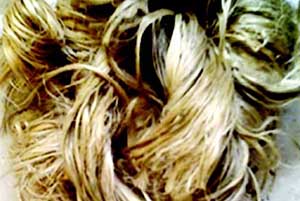Demand for raw jute, jute goods goes up in last two years
 The once flourishing jute industry is showing signs of a turnaround with production and export of jute and jute goods going up over the last two years.
The once flourishing jute industry is showing signs of a turnaround with production and export of jute and jute goods going up over the last two years.
Official sources and industry insiders attribute this to increased price of raw jute and demand for jute goods both at home and abroad.
Jute growers and producers of jute goods are now making renewed efforts to take advantage of the rising demand for their produce, and prices of those.
Against this backdrop, the land brought under jute cultivation rose 20 percent to 13.80 lakh acres in the current season from 11.50 lakh acres in the previous season, according to provisional estimates of the Department of Jute (DoJ).
The DoJ expects jute output this season will rise to 66 lakh bales from 59 lakh (1 bale equivalent to 180 kg), said a senior DoJ official, who sought anonymity.
The jute industry is now comprised of 20 public sector mills owned by Bangladesh Jute Mills Corporation (BJMC) and 149 private mills.
The BJMC has reopened four of its closed mills after the present government took the burden of its loans and provided funds to buy raw jute. This raised the number of mills under it to 20.
Production of these mills increased over the last two fiscal years. And some private mills also increased their production capacity with fresh investment to tap the buoyant market of the green products.
The industry, which employs 150,000 workers, posted a 50 percent growth in export earning in fiscal 2009-10, compared to the previous year, as prices rose sharply with China emerging as a key importer.
In the first 11 months of fiscal 2010-11, export earning from the industry surged 42 percent to $1,030 million from $725 million a year ago, shows the data from Export Promotion Bureau.
The buoyancy in export and prospect of increased use of jute products for packaging commodities–food grains, cement, fertiliser and sugar–have attracted over a dozen large and small new investors in the last two years. They include Partex Holdings, battery maker Panna Group and Aftab Group.
The demand in the domestic market will grow more if the government strictly enforces the new packaging act, which makes it mandatory to use jute goods in packaging, industry people say.
On the international front, industry stakeholders expect the demand for jute goods will rise further. Many advanced economies have started discouraging the use of polythene-based shopping bags fearing environmental degradation, they say.
”It appears that a vibrant mood and enthusiasm now prevail in the industry,” said a top BJMC official.
Industry insiders say the prospect of increased use of jute locally following the packaging act might give Bangladesh–the biggest exporter of jute–an edge in bargaining with foreign buyers for higher prices.
But they point out that charging higher prices continuously might lead to a dip in the demand for jute and a rise in the use of its substitute polythene.
”We have to remember that jute has to sustain by competing with its substitutes like polythene,” said Dr Khondaker Golam Moazzem, senior research fellow of the Centre for Policy Dialogue (CPD).
”For long-term sustainability of the sector, the core issue lies in the reduction of production cost and improvement in productivity so that jute can compete with its substitutes.
”Expansion of the domestic market is also important for long-term sustainability of the sector,” said Moazzem, citing the biggest jute producer–India–which consumes bulk of its production domestically.
He also suggested diversification of the export market.
Signs of a revival of jute industry are there; but there are a lot of challenges as well, said Moazzem.
Entrepreneurs will have to monitor the market constantly and sustain in the competition with the substitutes for jute, he said.
Moazzem suggested jute mills should go for an upgrade of technology and skills to enhance productivity and reduce production cost for sustainability of the industry in the long run.
Courtesy of The Daily Star




















